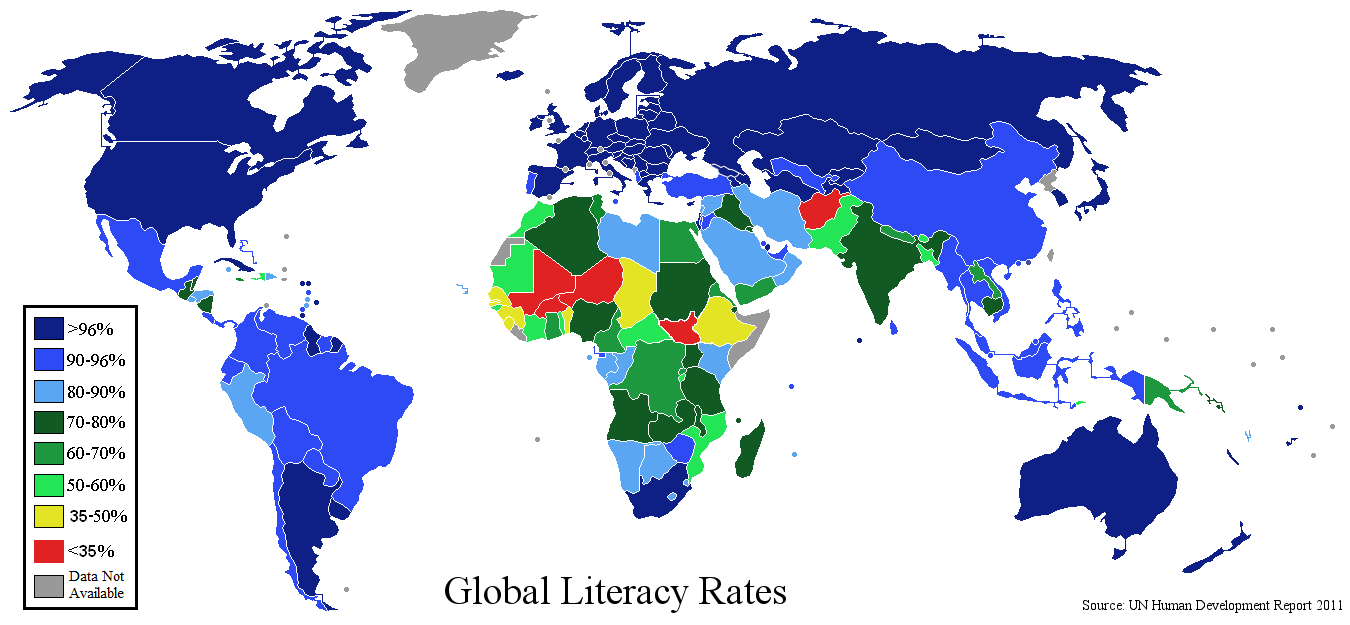Education has been around since before written history. In one form or another, people have taught other people about stuff they know, and sometimes even about stuff they don’t or can’t know.
Real “education for the masses” has been around for only a relatively short time, since the enlightenment. I’ll talk about the enlightenment specifically in a future post, so I won’t lose time here on the why’s and how’s. In Austria, we owe our first real school reform to Maria Theresa, Empress of Austria, in 1775. She made education compulsory for all 6 to 12 year olds, which was really revolutionary in these days. She caught a lot of flack for that.
Today in the world, we have a total literacy rate of roughly 85%. That number is slightly higher for men (88.5% in 2011) and lower for women (79.8% in 2011). I won’t talk about this here, though I will remark that this imbalance is atrocious.

Global Literacy Rates in 2011
One will note that the highest one gets in this graph is “>97%” literacy. That might strike some as odd, but remember that there are a fair number of people who can’t go to school, for one reason or another, and there is a surprisingly big number of functional illiterates. (That is to say, people can’t read and write well enough “to manage daily living and employment tasks that require reading skills beyond a basic level.”)
Functional illiterates are often thought to make up anywhere between 3% and 99% of the population. In less economically developed countries (LEDC’s), to give them their proper term, the numbers of literacy in itself is low (26.2% for Mali in 2009, see page 174) and the percentage of those 26% being functional illiterates may also be high. More economically developed countries (MEDC’s) tend to have higher literacy rates (usually calculated as 99% for the HDI), but may have huge rates of functional illiterates. Wikipedia claims nearly 50% for Italy in 2003, to name but one example.
These estimates are almost certainly too high. Official figures estimate about 200,000 to 400,000 functional illiterates (plus about 80,000 illiterates) in Austria, so anywhere between 2.5% and 5%.
How many people enrol in school? The numbers are a tad more difficult here. We would need to differentiate between different ethnic groups in the US to do this topic justice, but I don’t have time for that. The general trend is: Whites enrol more than Blacks than Hispanics. (Note: I am using the language from the National Center for Education Statistics (NCES).)
At most 40% of the population are enrolled in preschool, generally over 90% are enrolled from ages 7 to 17. Then, the numbers drop rapidly. About 30% of the population continue some kind of tertiary education, though half of these are 2-3 year courses. Only 16% of adults are still enrolled between the ages of 22 and 24 (generally the time needed for a Masters or equivalent), compared to about 25% of the population in Finland.
Another thing is worth mentioning in this post: PISA. Arguably the most important assessment of secondary education today is the PISA study. Done every three years, it sets out to test students in three areas (Reading literacy, Mathematics and Science) in a standardized manner. Among the top five countries (well, regions really) in the last few years were almost always Finland, Shanghai, Hong Kong and South Korea.
Now I don’t have data on South Korea’s system of education, nor on Hong Kong or Shanghai, but I think it’s fairly safe to expect that these countries are strongly influenced by at least one socialist trend: Long compulsory education for everybody. It’s certainly true for Finland.
If you want to learn more about various education systems in the EU, I suggest Eurypedia.
I want to end on a slightly depressing note. Research shows (unsourced, I think I read it in Hattie 2007) that between 60-80% of learning achievement can be predicted by looking at the background of children. (Note: Pasi Sahlberg claims about 2/3rds, so my figure is fairly accurate.) Are they from a rich family? Does the family care about education? Do the parents hold at least one degree?
This is a travesty in two ways: It means that, no matter what teachers and the education system of today are doing, we will almost certainly lose a large portion of the children. I hope that we will find ways to make this better.
Second, it means that economic inequality has lasting consequences on your descendants. That’s unacceptable, or should be. Society should work towards making society more equal. All working toward a common goal… wouldn’t that be nice?
In future posts, I will be talking about teaching strategies, effectiveness of teaching, the Hattie study, the politics of education and different systems of education. I want to use this post as a starting point for these later discussions.